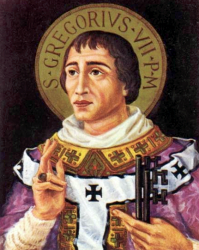Lives of the Saints
Our Models and Protectors
Spiritual Bouquet:
May 25

Saint Gregory VII
Pope
(1029-1085)
Gregory VII, one of the greatest of the Roman Pontiffs and one of the most remarkable men of all times, was known as Hildebrand before he became Pope. Born in Tuscany in 1020, he was sent to Rome to be educated under his uncle, who was Abbot of Saint Mary's monastery on the Aventine Hill. It was a time of great danger for the Church, when the Emperors of Germany were claiming it was their role to elect the successors of Saint Peter, the Vicars of Jesus Christ. They sold ecclesiastic dignities at auction or gave them to unworthy favorites, and many sees were occupied by persons who had obtained them with gold. It was this humble monk who had embraced the Benedictine Rule at the famous monastery of Cluny in France, who was chosen to bring a remedy to the current evils. The three great abuses, simony, concubinage, and the custom of receiving investiture from lay hands, seemed to threaten the very foundations of the Church. This great servant of God would never cease to oppose those corruptions of the reign of Christ.
Hildebrand was admired by the bishops of France when for a time he was at the Court of the Emperor Henry III. He returned to Rome with the bishop of Toul, who had been chosen Pope by the Emperor Henry III, and who invited him to accompany him. The young monk reproached him for having received from his relative a favor which should be granted only by the clergy and people of Rome; but when the bishop ceded to his arguments, he said he would accompany him if he would have his election ratified there. This was carried out, and Hildebrand became the right arm of the good Pope Leo IX. He was made a cardinal and named Superior of the Roman monastery of Saint Paul-Outside-the-Walls, which lay almost in ruins because the major part of its revenues had been usurped by powerful laymen. Hildebrand succeeded in recovering its lands and restored the monastery to its ancient splendor.
When Leo IX died, the clergy and people of Rome sent Hildebrand at the head of a delegation to the Emperor, with full power to elect a Sovereign Pontiff. It was he who chose Pope Victor II, against the Emperor's wishes, and again he became the right arm of the Pope in the combat against abuses. Pope Victor II sent him as legate to France, to stop the practice of simony in the collation of ecclesiastical benefices. He served as Archdeacon under three more Popes, Stephen II, Nicholas II and Alexander II. Upon the death of the last-named in 1073, he was compelled to fill the vacancy.
Pope Gregory VII immediately called upon the clergy throughout the world to lay down their lives rather than betray the laws of God to the will of princes. Rome was in rebellion due to the ambition of the Cenci, a family of Rome whose history is a series of acts of violence and crimes. Pope Gregory excommunicated them. As a consequence they laid hands on him during the Christmas midnight Mass, wounded him and cast him into prison; the following day the people rescued him. He then was forced to face Henry IV, Emperor of Germany, who openly relapsed into simony and claimed to depose the Pope. The Emperor too was excommunicated. The people turned against Henry and he sought absolution of Gregory at Canossa, but he regrettably did not persevere; he set up an antipope and besieged Gregory in the castle of Saint Angelo in Rome. The aged Pontiff was obliged to flee.
Opinion is unanimous that no Pontiff since the time of the Apostles undertook more labors for the Church or fought more courageously for her independence. While he was saying Mass, a dove was seen to come down on him; the Holy Spirit thus bore witness to the supernatural views which guided him in the government of the Church. Forced to leave Rome, he withdrew to Monte Cassino, and later to the castle of Salerno, where he died in 1085.
Les Petits Bollandistes: Vies des Saints, by Msgr. Paul Guérin (Bloud et Barral: Paris, 1882), Vol. 5; Heavenly Friends: a Saint for each Day, by Rosalie Marie Levy (Saint Paul Editions: Boston, 1958).